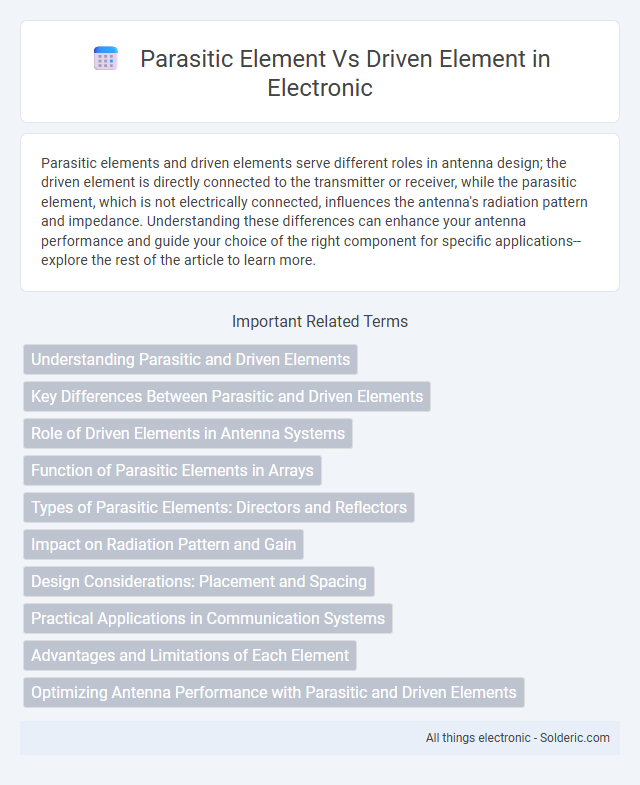Parasitic elements and driven elements serve different roles in antenna design; the driven element is directly connected to the transmitter or receiver, while the parasitic element, which is not electrically connected, influences the antenna's radiation pattern and impedance. Understanding these differences can enhance your antenna performance and guide your choice of the right component for specific applications--explore the rest of the article to learn more.
Comparison Table
| Feature | Parasitic Element | Driven Element |
|---|---|---|
| Definition | Element not directly connected to the transmitter; receives energy via mutual coupling. | Element directly connected to the transmitter; radiates RF energy. |
| Function | Shapes antenna radiation pattern by reflecting or directing signals. | Generates electromagnetic waves by driven current. |
| Connection | No direct electrical connection to feedline. | Directly connected to transmission line or feed point. |
| Examples | Reflector and director in Yagi-Uda antennas. | Dipole element in Yagi-Uda and other antennas. |
| Role in Antenna | Enhances gain and directivity. | Primary radiator of RF energy. |
Understanding Parasitic and Driven Elements
Parasitic elements and driven elements are fundamental components in antenna design, where the driven element is directly connected to the transmitter or receiver and actively radiates or receives signals. Parasitic elements, such as reflectors and directors, are not directly connected but influence the radiation pattern by reradiating energy, which enhances gain and directivity. Understanding these roles helps you optimize antenna performance by strategically positioning parasitic elements to shape signal direction and strength.
Key Differences Between Parasitic and Driven Elements
Parasitic elements do not have a direct connection to the transmitter or receiver, relying on induced currents from the driven element to function, whereas driven elements are directly connected and actively transmit or receive signals. Parasitic elements, such as directors and reflectors, shape the radiation pattern by enhancing gain and directivity, while driven elements serve as the primary source or sink of radio frequency energy. The distinct roles of these elements determine their placement and electrical characteristics within antenna arrays like Yagi-Uda configurations.
Role of Driven Elements in Antenna Systems
Driven elements serve as the primary source of signal excitation in antenna systems, directly connected to the transmitter or receiver, enabling efficient electromagnetic wave radiation or reception. The design and electrical length of the driven element critically influence the antenna's resonant frequency and impedance matching, optimizing signal transmission and reducing power loss. Proper integration of driven elements enhances overall antenna performance by ensuring targeted directionality and improved bandwidth.
Function of Parasitic Elements in Arrays
Parasitic elements in antenna arrays serve to modify the radiation pattern by reflecting or directing electromagnetic waves, enhancing gain and directivity without requiring a direct feed. These elements, typically passive metal rods like directors or reflectors, manipulate current distribution and phase relationships to shape the overall antenna performance. By strategically positioning parasitic elements around the driven element, arrays achieve improved front-to-back ratio and targeted signal focus for efficient wireless communication.
Types of Parasitic Elements: Directors and Reflectors
Parasitic elements in antenna arrays include directors and reflectors, which shape the radiation pattern without direct feed. Directors, positioned in front of the driven element, enhance forward gain and directivity by focusing energy in a specific direction. Reflectors, located behind the driven element, improve signal reception by reflecting energy toward the driven element, thus increasing antenna efficiency and front-to-back ratio.
Impact on Radiation Pattern and Gain
Parasitic elements, such as directors and reflectors, shape the antenna's radiation pattern by directing energy and enhancing forward gain, while driven elements actively receive or transmit RF signals, establishing the primary radiation source. The presence of parasitic elements typically narrows the beamwidth and increases gain by focusing the radiation pattern in a specific direction, improving directivity without needing additional power input. Your antenna's performance benefits from this interaction, achieving higher gain and more controlled radiation patterns compared to a driven-element-only design.
Design Considerations: Placement and Spacing
Parasitic elements in antenna arrays must be strategically placed relative to the driven element to optimize impedance matching and radiation pattern. Optimal spacing between driven and parasitic elements generally ranges from 0.1 to 0.25 wavelengths, balancing mutual coupling and gain enhancement. Precise element alignment and spacing reduce undesired interference and maximize signal directivity in Yagi-Uda antennas.
Practical Applications in Communication Systems
Parasitic elements, such as directors and reflectors in Yagi-Uda antennas, enhance signal directionality and gain without requiring direct electrical connection, optimizing antenna performance in communication systems. Driven elements actively receive or transmit radio frequency signals and serve as the antenna's primary source of radiation. Your communication setup benefits from a combination of driven and parasitic elements to improve signal clarity, range, and overall system efficiency.
Advantages and Limitations of Each Element
Parasitic elements enhance antenna gain and directivity by reflecting or reradiating signals without requiring a direct feed, making them ideal for simple, cost-effective designs like Yagi-Uda antennas; however, they lack independent control and tuning flexibility. Driven elements serve as the active radiator connected to the transmitter or receiver, allowing precise impedance matching and frequency control but often necessitate more complex feed mechanisms and potentially higher manufacturing costs. While parasitic elements improve overall antenna performance passively, driven elements provide essential functionality and versatility for wideband and adaptive communication systems.
Optimizing Antenna Performance with Parasitic and Driven Elements
Optimizing antenna performance involves carefully balancing driven and parasitic elements to enhance gain, directivity, and bandwidth. Driven elements receive direct RF energy, while parasitic elements--such as reflectors and directors--modify the radiation pattern by inducing currents without direct feed. This strategic arrangement improves overall antenna efficiency, radiation pattern shaping, and impedance matching for superior signal quality.
parasitic element vs driven element Infographic

 solderic.com
solderic.com